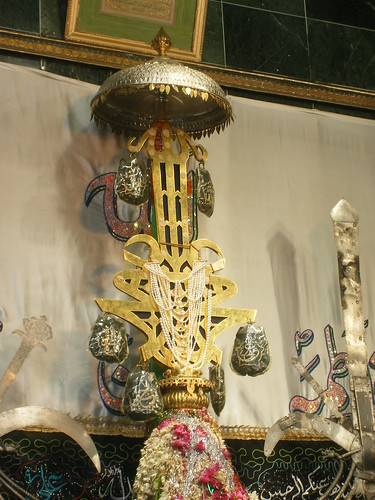Most Sacred Among Muharram Processions - Bibi Ka Alam
By Dr.Mazhar Naqvi




Bibi Ka Alam (Standard of Bibi) is probably the grandest and one of the oldest among all Muharram processions taken out in Indian sub- continent on ‘Yaum e-Ashura’ to commemorate the martyrdom of Imam Husain. Though it is dedicated to Bibi Fatima, daughter of Prophet Muhammad, wife of first Imam Hazrat Ali and mother of Imam Husain, the alam is carried on a caparisoned elephant on the last day of the first 10- day phase of Muharram mourning in Hyderabad.
The history of Bibi Ka Alam goes back to the time of Qutub Shahi Ruler Muhammad Qutub Shah. It is narrated that his wife installed an alam in the sacred memory of Bibi Fatima after one of her vows invoked in the name of Maula Husain’s mother got fulfilled. During Qutub Shahi period, the alam was kept with great respect and reverence in the Golconda fort but after the commencement of Asafjahi rule it was brought to its present location known as ‘Bibi Ka Alawa’ in Dabeerpura area of old city. Alawa is a Persian word and refers to a place where alams are kept with great care and respect.
All roads lead to ‘Bibi Ka Alawa’ in Dabeerpura on 10th of Muharram every year to take part in the procession. Dabeepura is one of the suburbs of old Hyderabad and is surrounded by Yaqutpura, Chanchalguda, Purani Haveli, Noorkhan Bazar and Azampura localities. All these areas are famous for their Muharram rituals. About 436 year old alam is revered by all and people rise above the caste, creed and religion to have a glimpse of its on Yaume Ashura because it contains a holy relic. The relic enclosed in the alam is a piece of the wooden plank on which Bibi Fatima was given her final ablution by her husband before burial. The relic is believed to have reached Golconda all the way from Karbala in Iraq during the reign of Golconda king Abdullah Qutub Shah. The ‘alam’ also contains six diamonds and other jewels donated by the last Nizam and builder of Azakhana-E-Madar-E-Deccan Mir Osman Ali Khan.
The procession starts in the afternoon amidst tight security arrangements and presence of government representatives and authorities from Bibi-ka-Alawa and culminates at Chaderghat in the evening after covering a distance of about five kilometers. Thousands of barefoot and bare-chested mourners from more than 40 ‘Anjumans’, including a few from other parts of the country form the major part of the procession. Carried on a well-trained elephant with camels preceding it, alam stops for a brief period at the Ashurkhana ‘Qadam-e-Rasul’ where the footprints of Prophet Mohammed are displayed. Then it halts at ‘Peeli Gate, Purani Haveli, where one of the members of the Nizam’s family offers a ‘dhatti’ to the Alam. The third stoppage is at the Alawa-e-Sartauq Mubarak near the Darul Shifa playground. At this place, women are allowed to perform Matam inside an enclosure for a short period of time. Then, the procession proceeds to make its fourth stop at Azakhana-E- Zehra, where a ‘dhatti’ is offered by a descendant of Nizam’s family.
Mir Osman Ali Khan attached so much importance to the procession that he used to walk barefoot behind the alam. Out of his veneration to the sacred alam, he had donated his most precious diamonds which now forms part of the holy relic and cast a dazzling effect on devotees. The Hyderabadis love so much the alam that they took the news of cracks in the relic with a sense of shock and grief. On public demand, The government directed the authorities of Salar Jung museum to inspect the alam a few years ago. They reported to the government and also the managing committee of alawa that alam had indeed suffered a crack and several rivets punched on the surface and they were likely to spoil its `look'. They attributed the crack to unscientific methods employed in its conservation since it was brought to Golconda more than 1300 years ago. The report, prepared by conservators namely Mohammad Samad, Syed Anwar Hussain and Ahmed Ali also mentioned that the repair work was taken up twice before but it failed to control the damage as it was carried out by non-professionals and unscientifically.
A similar concern had engulfed the city when it was reported that the central zoo Authority had asked the managing trust to either take the ownership of elephant used for carrying Bibi Ka Alam or else it would be transferred to any wildlife sanctuary. The Zoo authorities were following a direction from the government of India that elephants can’t be kept inside a zoo. History reveals that Bibi Ka alam was always carried on elephant. Initially, it was carried upon an elephant named Haideri and then another elephant, Hashmi, carried it. For the past several years, Rajni has been performing this solemn duty. ( Reference available on request)
No comments:
Post a Comment